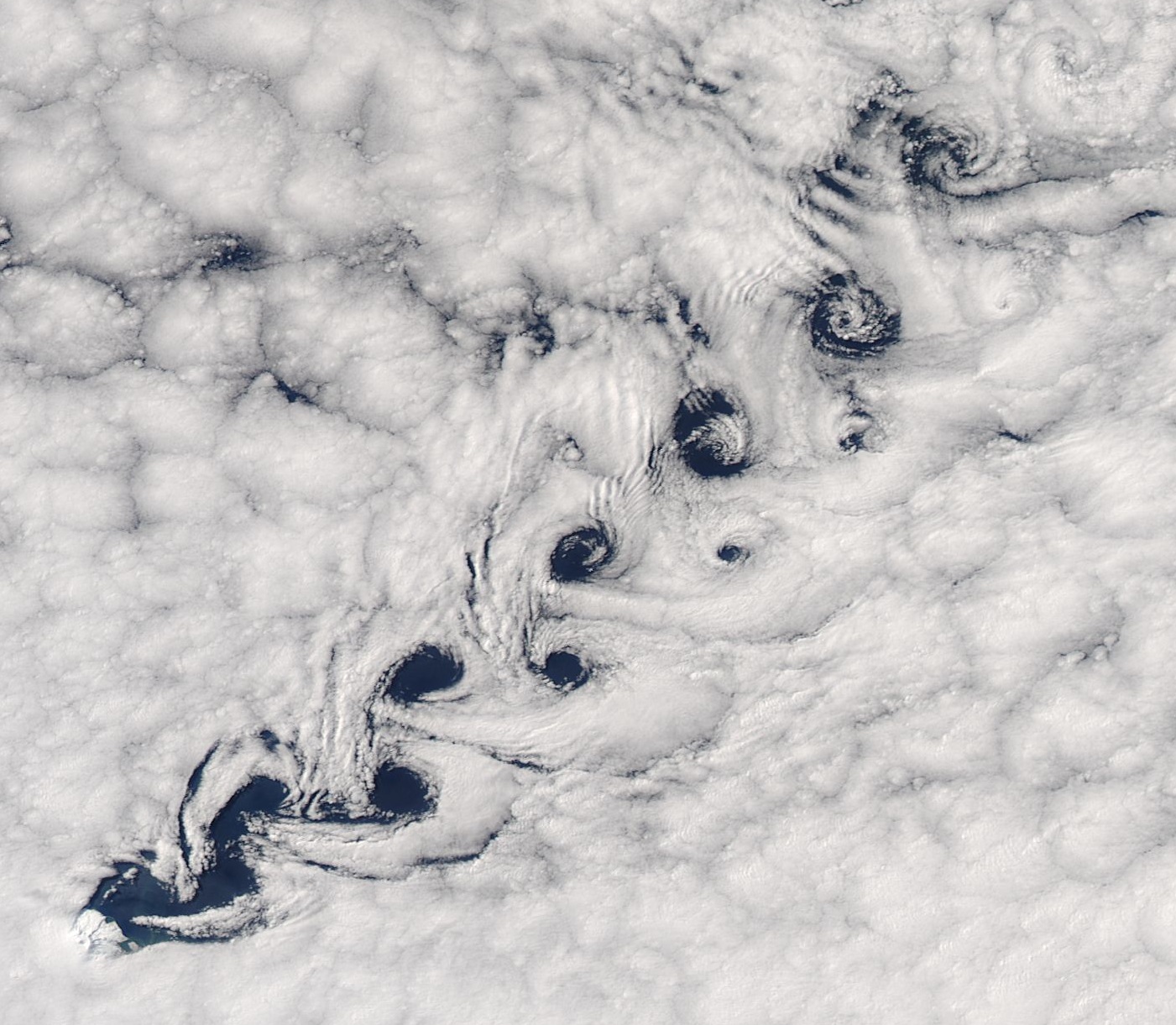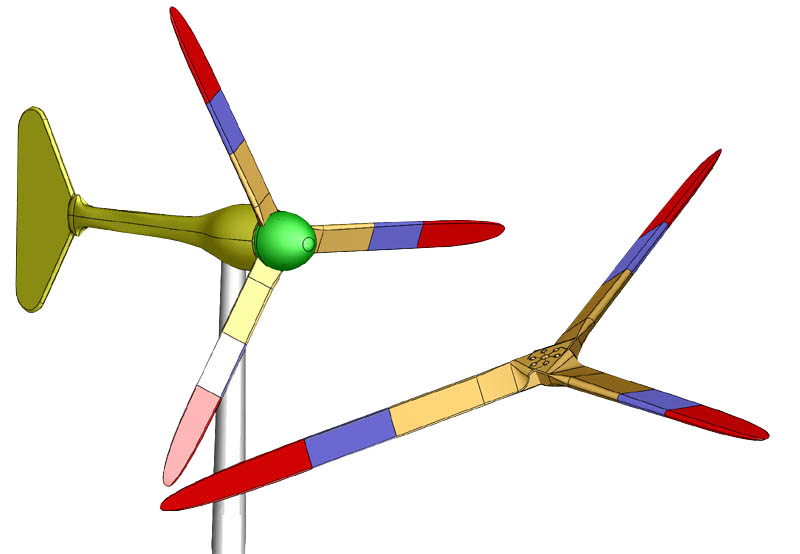|
Windbelt
The Windbelt is a wind power harvesting device invented by Shawn Frayne in 2004 for converting wind power to electricity. It consists of a flexible polymer ribbon stretched between supports transverse to the wind direction, with magnets glued to it. When the wind blows across it, the ribbon vibrates due to vortex shedding, similar to the action of an aeolian harp. The vibrating movement of the magnets induces current in nearby pickup coils by electromagnetic induction. One prototype has powered two LEDs, a radio, and a clock (separately) using wind generated from a household fan. The cost of the materials was well under US$10. $2–$5 for 40 mW is a cost of $50–$125 per watt. There are three sizes in development: * The microBelt, a 12 cm version. This could be put into production in around six months. Its expected to produce 1 milliwatt average. To charge a pair of ideal rechargeable AA cells (2.5Ah 1.2v) this would take 6000 hours, or 250 days. * The Windcell, ... [...More Info...] [...Related Items...] OR: [Wikipedia] [Google] [Baidu] |
Wind Power
Wind power or wind energy is mostly the use of wind turbines to electricity generation, generate electricity. Wind power is a popular, sustainable energy, sustainable, renewable energy source that has a much smaller Environmental impact of wind power, impact on the environment than burning fossil fuels. Historically, wind power has been used in sails, windmills and windpumps but today it is mostly used to generate electricity. Wind farms consist of many individual wind turbines, which are connected to the electric power transmission Electrical grid, network. New Onshore wind farm, onshore (on-land) wind farms are cheaper than new Coal-fired power station, coal or Gas-fired power plant, gas plants, but expansion of wind power is being hindered by fossil fuel subsidies. Onshore wind farms have a greater visual #Impact on environment and landscape, impact on the landscape than some other power stations. Small onshore wind farms can feed some energy into the grid or provide power t ... [...More Info...] [...Related Items...] OR: [Wikipedia] [Google] [Baidu] |
Vortex Shedding
In fluid dynamics, vortex shedding is an oscillating flow that takes place when a fluid such as air or water flows past a bluff (as opposed to streamlined) body at certain velocities, depending on the size and shape of the body. In this flow, vortices are created at the back of the body and detach periodically from either side of the body forming a Kármán vortex street. The fluid flow past the object creates alternating low-pressure vortices on the downstream side of the object. The object will tend to move toward the low-pressure zone. If the bluff structure is not mounted rigidly and the frequency of vortex shedding matches the resonance frequency of the structure, then the structure can begin to resonate, vibrating with harmonic oscillations driven by the energy of the flow. This vibration is the cause for overhead power line wires humming in the wind, and for the fluttering of automobile whip radio antennas at some speeds. Tall chimneys constructed of thin-walled steel t ... [...More Info...] [...Related Items...] OR: [Wikipedia] [Google] [Baidu] |
Aeolian Harp
An Aeolian harp (also wind harp) is a musical instrument that is played by the wind. Named for Aeolus, the ancient Greek god of the wind, the traditional Aeolian harp is essentially a wooden box including a sounding board, with strings stretched lengthwise across two bridges. It is often placed in a slightly opened window where the wind can blow across the strings to produce sounds. The strings can be made of different materials (or thicknesses) and all be tuned to the same pitch, or identical strings can be tuned to different pitches. Besides being the only string instrument played solely by the wind, the Aeolian harp is also the only string instrument that plays solely harmonic frequencies. They are recognizable by the sound which is a result of this property, which has been described as eerie and ethereal. The Aeolian harp – already known in the ancient world – was first described by Athanasius Kircher (1602–1680) in his books ''Musurgia Universalis'' (1650) and ''Phonu ... [...More Info...] [...Related Items...] OR: [Wikipedia] [Google] [Baidu] |
Electromagnetic Coil
An electromagnetic coil is an electrical Electrical conductivity, conductor such as a wire in the shape of a wiktionary:coil, coil (spiral or helix). Electromagnetic coils are used in electrical engineering, in applications where electric currents interact with magnetic fields, in devices such as electric motors, Electric generator, generators, inductors, electromagnets, transformers, and sensor coils. Either an electric current is passed through the wire of the coil to generate a magnetic field, or conversely, an external ''time-varying'' magnetic field through the interior of the coil generates an Electromotive force, EMF (voltage) in the conductor. A current through any conductor creates a circular magnetic field around the conductor due to Ampere's circuital law, Ampere's law. The advantage of using the coil shape is that it increases the strength of the magnetic field produced by a given current. The magnetic fields generated by the separate turns of wire all pass throug ... [...More Info...] [...Related Items...] OR: [Wikipedia] [Google] [Baidu] |
Electromagnetic Induction
Electromagnetic or magnetic induction is the production of an electromotive force (emf) across an electrical conductor in a changing magnetic field. Michael Faraday is generally credited with the discovery of induction in 1831, and James Clerk Maxwell mathematically described it as Faraday's law of induction. Lenz's law describes the direction of the induced field. Faraday's law was later generalized to become the Maxwell–Faraday equation, one of the four Maxwell equations in his theory of electromagnetism. Electromagnetic induction has found many applications, including electrical components such as inductors and transformers, and devices such as electric motors and generators. History Electromagnetic induction was discovered by Michael Faraday, published in 1831. It was discovered independently by Joseph Henry in 1832. In Faraday's first experimental demonstration (August 29, 1831), he wrapped two wires around opposite sides of an iron ring or "torus" (an arrangement ... [...More Info...] [...Related Items...] OR: [Wikipedia] [Google] [Baidu] |
Popular Mechanics
''Popular Mechanics'' (sometimes PM or PopMech) is a magazine of popular science and technology, featuring automotive, home, outdoor, electronics, science, do-it-yourself, and technology topics. Military topics, aviation and transportation of all types, space, tools and gadgets are commonly featured. It was founded in 1902 by Henry Haven Windsor, who was the editor and—as owner of the Popular Mechanics Company—the publisher. For decades, the tagline of the monthly magazine was "Written so you can understand it." In 1958, PM was purchased by the Hearst Corporation, now Hearst Communications. In 2013, the US edition changed from twelve to ten issues per year, and in 2014 the tagline was changed to "How your world works." The magazine added a podcast in recent years, including regular features ''Most Useful Podcast Ever'' and ''How Your World Works''. History ''Popular Mechanics'' was founded in Chicago by Henry Haven Windsor, with the first issue dated January 11, 1902. ... [...More Info...] [...Related Items...] OR: [Wikipedia] [Google] [Baidu] |
Small Wind Turbine
Small wind turbines, also known as micro wind turbines, are used for microgeneration of electricity, as opposed to large commercial wind turbines, such as those found in wind farms. Small wind turbines often have passive yaw systems as opposed to active ones. They use a direct drive generator and use a tail fin to point into the wind, whereas larger turbines have geared powertrains that are actively pointed into the wind. Small wind turbines typically produce between 500 W and 10 kW of power, although the smaller turbines may be as small as a 50 Watt auxiliary power generator for a boat, caravan, or miniature refrigeration unit, and the Canadian Wind Energy Association (CanWEA) defines "small wind" as high as 300 kW. The IEC 61400 Standard defines small wind turbines as wind turbines with a rotor swept area smaller than 200 m2, generating at a voltage below 1000 Va.c. or 1500 Vd.c. Design Blades Smaller scale turbine blades are usually in diameter and produce 0.5-10 ... [...More Info...] [...Related Items...] OR: [Wikipedia] [Google] [Baidu] |
Wind Power
Wind power or wind energy is mostly the use of wind turbines to electricity generation, generate electricity. Wind power is a popular, sustainable energy, sustainable, renewable energy source that has a much smaller Environmental impact of wind power, impact on the environment than burning fossil fuels. Historically, wind power has been used in sails, windmills and windpumps but today it is mostly used to generate electricity. Wind farms consist of many individual wind turbines, which are connected to the electric power transmission Electrical grid, network. New Onshore wind farm, onshore (on-land) wind farms are cheaper than new Coal-fired power station, coal or Gas-fired power plant, gas plants, but expansion of wind power is being hindered by fossil fuel subsidies. Onshore wind farms have a greater visual #Impact on environment and landscape, impact on the landscape than some other power stations. Small onshore wind farms can feed some energy into the grid or provide power t ... [...More Info...] [...Related Items...] OR: [Wikipedia] [Google] [Baidu] |
Electrical Generators
In electricity generation, a generator is a device that converts motive power (mechanical energy) or fuel-based power ( chemical energy) into electric power for use in an external circuit. Sources of mechanical energy include steam turbines, gas turbines, water turbines, internal combustion engines, wind turbines and even hand cranks. The first electromagnetic generator, the Faraday disk, was invented in 1831 by British scientist Michael Faraday. Generators provide nearly all of the power for electric power grids. In addition to electromechanical designs, photovoltaic and fuel cell powered generators utilize solar power and hydrogen-based fuels, respectively, to generate electrical output. The reverse conversion of electrical energy into mechanical energy is done by an electric motor, and motors and generators have many similarities. Many motors can be mechanically driven to generate electricity; frequently they make acceptable manual generators. Terminology Electromagn ... [...More Info...] [...Related Items...] OR: [Wikipedia] [Google] [Baidu] |





